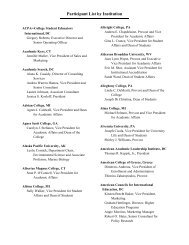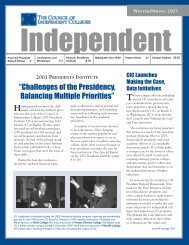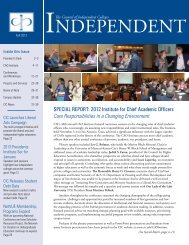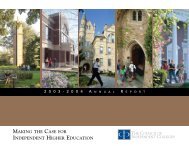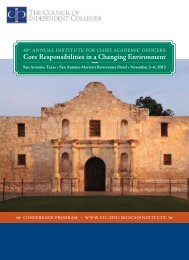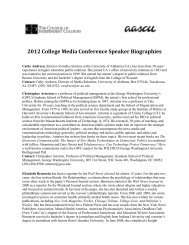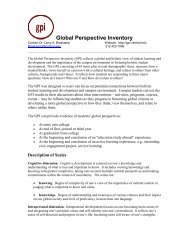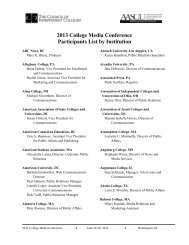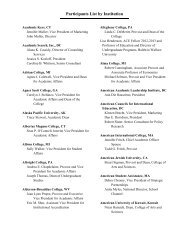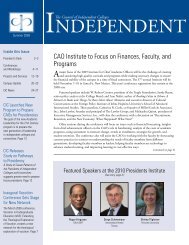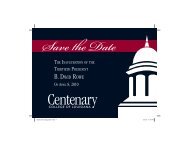Meeting the Challenge: - The Council of Independent Colleges
Meeting the Challenge: - The Council of Independent Colleges
Meeting the Challenge: - The Council of Independent Colleges
Create successful ePaper yourself
Turn your PDF publications into a flip-book with our unique Google optimized e-Paper software.
John R. <strong>The</strong>lin<br />
“<strong>The</strong> undergraduate experience at small, residential, liberal arts colleges tends<br />
to promote strong cognitive growth, <strong>the</strong> development <strong>of</strong> solid<br />
values, and a high rate <strong>of</strong> degree completion.”<br />
–Alexander Astin, Founding Director, Higher Education Research Institute, UCLA<br />
<strong>The</strong> short-term result <strong>of</strong> Ford’s influence was<br />
enhanced external support for independent liberal arts<br />
colleges in a time <strong>of</strong> continuing financial crisis. <strong>The</strong> longterm<br />
benefit was streng<strong>the</strong>ning <strong>the</strong> tradition <strong>of</strong> large-scale<br />
philanthropic support for higher education. Viewed in<br />
tandem, <strong>the</strong>se two emphases constituted an effective support<br />
strategy. Philanthropy that limited itself to underwriting<br />
bold, innovative programs provided incentives for cuttingedge<br />
exploration at <strong>the</strong> colleges. In contrast, <strong>the</strong> direct<br />
support for raising faculty salaries helped colleges maintain<br />
“business as usual” and <strong>the</strong>n do more. In fact, this apparently<br />
conservative approach had a strong multiplier effect that<br />
invigorated liberal arts colleges. It meant that <strong>the</strong>y now could<br />
compete against o<strong>the</strong>r kinds <strong>of</strong> institutions both to retain<br />
established faculty members and attract Ph.D. recipients<br />
from leading universities as new faculty members. Thanks<br />
to foundation support, liberal arts colleges were increasingly<br />
able to attract a new generation <strong>of</strong> committed scholars to<br />
<strong>the</strong>ir teaching ranks. <strong>The</strong> challenge for a president or provost<br />
was to identify those graduate students at major universities<br />
who combined skills in advanced research with an essential<br />
passion for teaching and undergraduate education.<br />
Innovation and Public Policies<br />
<strong>The</strong> great experiment in American postsecondary<br />
education over <strong>the</strong> past half century has been <strong>the</strong><br />
development <strong>of</strong> federal and state policies intended to make<br />
college accessible to almost every student who seeks to<br />
participate. <strong>The</strong> higher education sector has attempted to<br />
increase <strong>the</strong> varieties <strong>of</strong> educational settings and experiences<br />
from which students can choose, while making sure that<br />
students are able to afford <strong>the</strong> tuition and o<strong>the</strong>r college<br />
expenses in every setting. This ambitious venture has been<br />
both uncertain and uneven in its accomplishments.<br />
Alexander Astin, <strong>the</strong> founding director <strong>of</strong> UCLA’s<br />
Higher Education Research Institute, has studied <strong>the</strong><br />
differential impacts and outcomes <strong>of</strong> <strong>the</strong> college experience<br />
for more than four decades. His research provides useful<br />
information and much good news for <strong>the</strong> independent sector<br />
<strong>of</strong> higher education. According to Astin, “<strong>the</strong> undergraduate<br />
experience at small, residential, liberal arts colleges tends<br />
to promote strong cognitive growth, <strong>the</strong> development <strong>of</strong><br />
solid values, and a high rate <strong>of</strong> degree completion.” He first<br />
reported this set <strong>of</strong> outcomes in his 1977 study Four Critical<br />
Years and reconfirmed his findings in a 1993 follow-up study,<br />
What Matters Most in College Astin’s systematic research<br />
supports <strong>the</strong> long-term contention <strong>of</strong> independent colleges<br />
15



